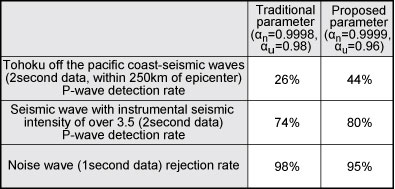4. Improvement of P wave detection in earthquake early warning system
- Efficiency in detecting P-waves recorded during the 2011 off the pacific coast of Tohoku earthquake was raised from 26% to 44%.
- This allows faster estimation of earthquake magnitude, which in turn contributes to the goal of cutting the time before warnings are issued.
- Use of optimised parameters should improve the overall functionality of the earthquake early warning system.
In order to improve detection of P-waves as opposed to slower increasing seismic waves, research has been carried out to find the optimal P-wave detection parameter used for the Japanese high speed train early earthquake warning system (EEW system).
The current method used to identify P-waves in the EEW system compares long time amplitude averages (noise level) with short time period levels (amplitude level) (Fig.1).
Generally, when attempts are made to improve P-wave detection, there is an increase in false warnings because noises other than seismic waves are detected.
In order to maintain the effectiveness of the anti-noise function, first, other related parameters were subjected to a sensitivity analysis. Then, while keeping a control on false positive detection, the parameters which could improve detection of slower increasing seismic waves were extracted. The extracted parameters form the smoothing coefficient to be applied to the noise and amplitude levels (¿n and ¿u in Fig.1j.
Next, the optimal values for the parameters mentioned above were found for 12051 seismic wave forms and 32018 noise wave forms including the eTohoku off the pacific coast earthquakef. Based on these, confirmation was obtained that P-wave detection within 250 km of the epicenter of this earthquake was improved from 26 to 44 %. Furthermore the time lapse to estimation of earthquake magnitude from the P-wave was decreased, which shows that this method would allow faster issuing of warnings. B

Fig.1 P-wave detection method- Table 1 Changes in detection function after altering parameters
